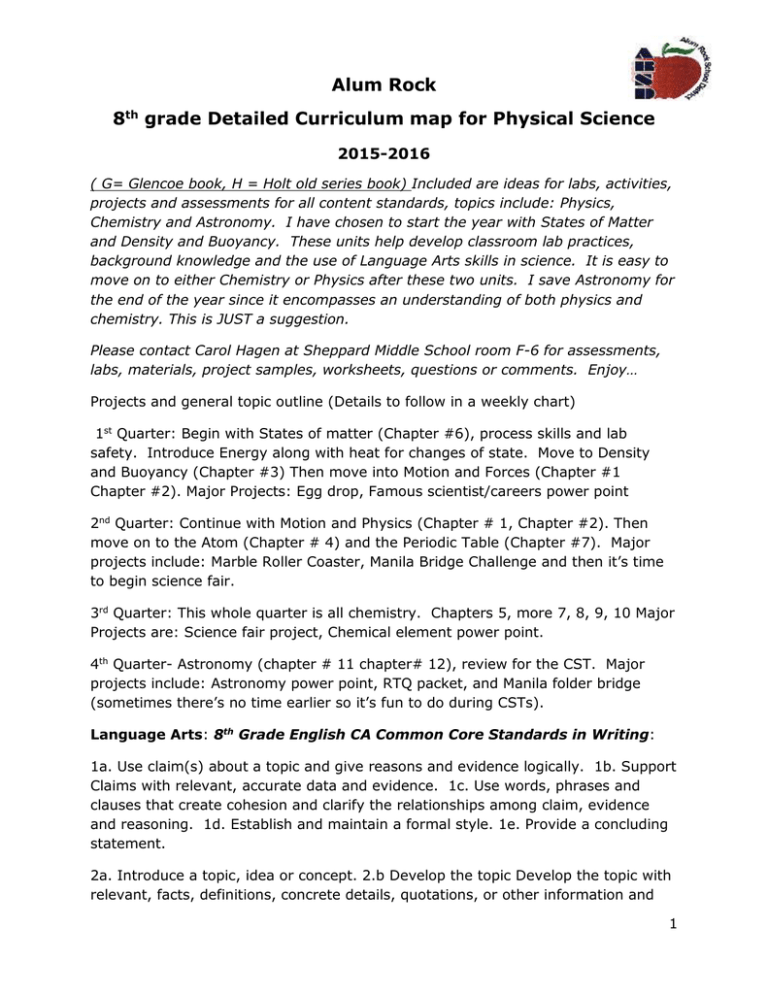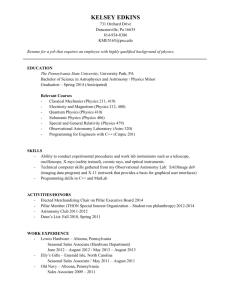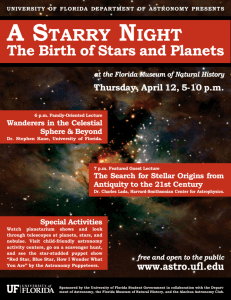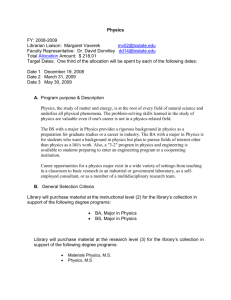8th Grade - Alum Rock Union School District
advertisement

Alum Rock 8th grade Detailed Curriculum map for Physical Science 2015-2016 ( G= Glencoe book, H = Holt old series book) Included are ideas for labs, activities, projects and assessments for all content standards, topics include: Physics, Chemistry and Astronomy. I have chosen to start the year with States of Matter and Density and Buoyancy. These units help develop classroom lab practices, background knowledge and the use of Language Arts skills in science. It is easy to move on to either Chemistry or Physics after these two units. I save Astronomy for the end of the year since it encompasses an understanding of both physics and chemistry. This is JUST a suggestion. Please contact Carol Hagen at Sheppard Middle School room F-6 for assessments, labs, materials, project samples, worksheets, questions or comments. Enjoy… Projects and general topic outline (Details to follow in a weekly chart) 1st Quarter: Begin with States of matter (Chapter #6), process skills and lab safety. Introduce Energy along with heat for changes of state. Move to Density and Buoyancy (Chapter #3) Then move into Motion and Forces (Chapter #1 Chapter #2). Major Projects: Egg drop, Famous scientist/careers power point 2nd Quarter: Continue with Motion and Physics (Chapter # 1, Chapter #2). Then move on to the Atom (Chapter # 4) and the Periodic Table (Chapter #7). Major projects include: Marble Roller Coaster, Manila Bridge Challenge and then it’s time to begin science fair. 3rd Quarter: This whole quarter is all chemistry. Chapters 5, more 7, 8, 9, 10 Major Projects are: Science fair project, Chemical element power point. 4th Quarter- Astronomy (chapter # 11 chapter# 12), review for the CST. Major projects include: Astronomy power point, RTQ packet, and Manila folder bridge (sometimes there’s no time earlier so it’s fun to do during CSTs). Language Arts: 8th Grade English CA Common Core Standards in Writing: 1a. Use claim(s) about a topic and give reasons and evidence logically. 1b. Support Claims with relevant, accurate data and evidence. 1c. Use words, phrases and clauses that create cohesion and clarify the relationships among claim, evidence and reasoning. 1d. Establish and maintain a formal style. 1e. Provide a concluding statement. 2a. Introduce a topic, idea or concept. 2.b Develop the topic Develop the topic with relevant, facts, definitions, concrete details, quotations, or other information and 1 examples. 2c. Use appropriate transitions to create cohesion and clarify the relationships among ideas and concepts. 2d. Use precision language and domainspecific vocabulary to inform about or explain the topic. 2 e. Establish and maintain a formal style. 2f. Provide a concluding statement. Writing in Science: All 8th graders should use these in all their written work. a. Introduce claims about a topic or issue, acknowledge and distinguish the claim(s) from alternate or opposing claims, and organize the reasons and evidence logically. b. Support claim(s) with logical reasoning and relevant, accurate data and evidence that demonstrate an understanding of the topic or text, using credible sources. c. Use words, phrases, and clauses to create cohesion and clarify the relationships among claim(s) reasons, and evidence. d. Establish and maintain a formal style. e. Provide a concluding statement or section that follows from and supports the argument presented. Speaking and Listening Standards -8th Grade Comprehension and Collaboration 1 Engage effectively in a range of collaborative discussions (one-on-one, in groups, and teacher led) with diverse partners on grade 7 topics, texts and issues, building on others’ ideas and expressing their own clearly. 2a. Come to discussion prepared, having read or researched material under study; explicitly draw on that preparation by referring to evidence on the topic, text, or issue to probe and reflect on ideas under discussion. Reading Standards ELA for Grade 7-: Cite several pieces of textual evidence to support analysis of what the text says explicitly as well as inferences drawn from the text. Bold worksheets are Page Keeley Assessment Probes (Column # 2, (G=Glencoe book and H=Holt book.) Any science book provides adequate reading. The most significant difference in teaching science is the activities, labs, and projects you provide for the students. Developing Crosscutting concepts in science is best accomplished with engaging, student involved activities. The Cross cutting concepts are: Patterns- Cause and Effect- Scale, proportion and Quantity- Systems and System Models – Energy and matter- Structure and Function- Stability and Change. (Energy and matter is Physics and Chemistry!) 2 Once you have taught a writing skill, include it in all the labs, activities and probes where appropriate. Include class discussions using vocabulary and provide sentence frames to encourage proper use of content vocabulary. Please attend our Professional Development sessions for more activities, ways to infuse Common Core, and to share your ideas. See you there! Week & old standards August 26- 31 9a, 9b, Topic & assessments (BOLD) Keeley Class rules, structure, journals MS Dictionary Lab Safety Scientific Method -Is it a Theory -Ice Cubes in a Baggie Intro. States of matter Chapter # 6 Tools test Sept. 1-4 3d, 3e, 9a, 9b Sept 7-11 3d, 3e, 9a, 9b Metric conversion MS vocabularyGlencoe page 272. -Is it matter -Thermometer States of matter 3 story intellect # 5 Ice cubes in a Baggie Science process skills – collecting and graphing data Ch. # 6 content vocabulary & concepts… condense, evaporate sublimate, Book pages H = Holt G = Glencoe H 610matter & energy Tools G 7-14 H 1119Scientific method G 5-6, 1920, 29-33 H 512-514 Labs/ activities Literacy & math H 24-27tools G 15-18 metric H 128-129 mass LA- summary writing in a conclusion Black boxes Claim/ Evidence Cornell notes with Bill Nye DVD Glencoe lab pg. 276-277 Changing states using a thermometer/ Or/ using scales to find mass. Burning Candle lab G 20-23 models H 60-64 G 254-260 States H 68-73 G 261-273 Changes Favorite subject walk around Show tools Discussions of Assessments and Initial writing of claim evidence. DVDs / homework/ worksheets Tools/ safety parent signature Is it Theory Is it matter? Matter/ Energy Theory Melting Ice in a Baggie lab Review writing a conclusion and finishing the Cornell notes for Bill NyePhases of matter Observe & infer Temp. scales Melt & freeze Condensation/ Evaporation Bill NyeEnergy Mass, volume Changing volume 3 vaporize, deposition -Is it melting TEST Ch. #6Sept. 14-18 9a, 9b Sept. 21-25 8a, 8b, 8c, 8d 9a, 9b Sept. 28Oct. 2 8a, 8b, 8c, 8d 9a, 9b Oct. 5-9 8a, 8b, 8c, 8d 9a, 9b Oct. 12-16 8a, 8b, 8c, 8d 9a, 9b Oct. 19-23 1a, 1b, 1c, 1d, 1e, 1f, -Is it solid Famous scientist or Technical career power point project Density Ch. # 3 Inquiry- Cartesian Diver -Salad DressingDouble layer assessment Implement IMSS liquid density sequence here… -Four layer pour Density formula Manipulating variables Displacement method -Comparing Cubes Assign Egg Drop project Density as a physical property Revisit –Salad Dressing probe Buoyancy and pressure Chapter # 3 test EGG drop day! Day after test! IMSS motion intro unit. -Roller coaster G 36- 41 H 214-219 138-139, 140 G 48-54 Energy study guide Ch.# 6 Volume worksheets measurements, + displacement method Scales lab H 45-46 G 130-135 DO not read! Start unit with Inquiry IMSS unit Liquid Density. H 68-73 G 21-273 G 136-137 H162-167, 64-66 G 140-148 Salad dressing Observe liquids 2 liquid pour 4 liquid layering Density formula Calculating the density of four liquids. water density 20ml and 40 ml. Density of two new unknown liquids Density cubes lab Claims, Evidence Reasoning formats for lab write ups!! Density of chocolate lab Density of irregular objects Soda can Buoyancy in a tub demo lab Claim, evidence Reasoningmultiple sources. Marble challenge on a table IMSS density unit beginning With inquiry using 4 liquids Density intro worksheet Bill NyeFluids Density calculations worksheet (series of 3) Bill Nye – Buoyancy Viscosity Bill NyePressure Pressure Class time to work on Marble roller 4 9a, 9b, 9d, 9e Oct. 26 – 30 1a, 1b, 1c, 1d, 1e, 1f, 9a, 9b, 9d, 9e Nov. 2-6 1a, 1b, 1c, 1d, 1e, 1f, 9a, 9b, 9d, 9e Nov 9-13 1a, 1b, 1c, 1d, 1e, 1f, 9a, 9b, 9d, 9e Nov. 16-20 1a, 1b, 1c, 1d, 1e, 1f, 9a, 9b, 9d, 9e Nov. 23-24 1a, 1b, 1c, 1d, 1e, 1f, 9a, 9b, 9d, 9e Nov. 30Dec. 4 2a, 2b, 2c, 2d, 2e, 2f, 2g, 9d, 9e Dec 7-11 26-27 2a, 2b, 2c, 2d, 2e, 2f, 2g, 9d, 9e ride -Following jack part 1 -Following jack part II -Nascar Racing Motion – Chapter # 1 test Introduce marble roller coaster G 54-58 H 108-109 H 110-111 velocity G 54-58 H 108-109 H 110-111 velocity G 60-71 H 112-114 acceleration -Apple on a desk Friction -Friction -Experience -Gravity ( # 34) Gravity and motion Free fall, orbit motion Types of forces – Kinetic Energy / Gravitational energy lab Inertia 3 meter acceleration lab Data collection from Roller coasters lab -Equal and Opposite -Force and motion ideas Average speed lab Wheels AlaCart Drip Acceleration lab H H H H 145-147 119-124 148-149 150-153 G 93, 106114 G 96-98 H 117-118 G 88-92, 99-100 H 115, 119-124 Newton’susing a spring scale Newtonian Demo lesson Straw tower challenge Sandpaper surfaces lab with spring scales Holt pg. 540 coasters. Good time to introduce MS vocabulary! A few words a day!!! IMSS motion inquiry lessons Bill NyeMotion Average speed Bill NyeMomentum Force homework Bill NyeStructure Force homework 2 Falling objects Bill NyeGravity 2nd law mass 2nd law motion 2nd law acceleration Bill NyeFriction Velocity Acceleration H 125-129 H 138-144 Centripetal forces G Bill Nye – Balance 5 Dec. 14-16 26-27 2a, 2b, 2c, 2d, 2e, 2f, 2g, 9d, 9e Dec. 17-18 Inertia and mass -Talk about Forces Work & power Mechanical advantage Chapter #2 test 2a, 2b, 2c, 2d, 2e, 2f, 2g, 9d, 9e Christmas Break!!! Notes to get Page Keeley for you started Chemistry… after the Physical Science break- All bk. the chem. Pizza Dough 31 assessments Weighing water 33 H( 188-191) H (196197) Holt pg. 542 Marshmallow Catapult – Angles of launch. Mechanical advan. Acceleration review Word problems 2nd law Introduce science fair ideas … (Time to do a fun lab!!) Book 1 Lemonade 6 Cookie crumble 7 Is it made of molecules 11 Rusty nails 12 Book 4 Sugar water & Iron Bar H 43-44 matter H 82-85 elements G 313-318 Physical properties lab Mystery Powders Physical change Physical Properties Drawing models of atoms Bill Nye- Heat Soap opera of atoms Bill Nye – the Atom Book 2 Bubble 8 Chemical bonds 9 Atoms and cells Science fair for county participants applications due Jan 4-8 3a, 3b, 3d, 9a, 9b Jan. 11-15 3a, 3b, 3d, 9a, 9b Jan 18-22 3a, 3b, 3d, Begin matter & properties Physical changes( same as change of state) -Atoms and cells The Atom – neutrons, protons, and electrons -Is it made of molecules Discovering the atom G 174-179 H 311-314 G 182-194 H 304-310 6 9a, 9b Jan 25-29 7a, 7b, 7c, 9a, 9b Feb 1-5 7a, 7b, 7c, 9a, 9b Feb. 8-12 7a, 7b, 7c, 9a, 9b, 3f,6a, 6b Feb. 22-26 7a, 7b, 7c, 9a, 9b, 6c Feb 29-Mar 4 5a, 5b, 5c, 5d, 5e March 7-11 5a, 5b, 5c, 5d, 5e, 3f, 3c, 3d Arrangement of the periodic table 1st 10 -Water and Iron Bar IMSS periodic table using a calendar and matching shapes organization activities. -Weighing water Organization of the periodic table Elements power point project!!! Grouping of Elements in the periodic table Radioactivity, isotopes Electrons and bonding Chapter # 7 test Continue with Chemical bonding - using the periodic table -Pizza Dough FEBRUARY BREAK!! Forming compounds, molecules Forming solids, crystals, polymers Chemical changes, chemical reactions Writing and balancing chemical formulas -Rusty nails Endothermic and exothermic reactions GET full IMSS unit lesson sequence for introducing the periodic table G 290-293 intro H 324, 326333 G 294-299 H 334-341 G 301-310 isotope H 352-365 *** H 352-365 Memorize 20 elements Elements VS compounds VS mixtures lab Lab using density cubes for ID of element/ compound Bill Nye- Do it yourself science Bill NyeInventions Bill NyeMagnetism SCIENCE FAIR!?! G 218-228 H 398-400 G 230-237 G H G H 338-344 374-381 346-356 382-384 G 358-363 H 385-389 Rock candy lab Viewing crystals with a microscope Worksheets on balancing equations Chemical changes lab. Chemical reactions lab… Bill NyeChemical reactions Bill NyeElectrical Current Bill NyeSpinning Things 7 March 14-18 5a, 5b, 5c, 5d, 5e March 2125 25-29 5a, 5b, 5c, 5d, 5e April 4-8 6a, 6b, 6c April 11-15 4a, 4b, 4c, 4d, 4e April 18-29 4a, 4b, 4c, 4d, 4e May 2-6 ALL standards May 9-13 4a, 4b, 4c, 4d, 4e -What’s in the bubbles Test on Ch. # 8 Solutions, mixtures Suspensions, colloids -Lemonade Cookie Acids and Bases, pH -Chemical Bonds Chapter # 9 test Organic compounds (Carbon based life!) Begin Astronomy and begin reviewing with RTQ’s Solar system forms -Apple in the plane -Outer space push Chapter # 11 – Solar system Moons, asteroids, comets STAR testing – manila bridge construction Chapter # 12 Stars Formation of G 380-392 H 90-97 Solubility lab Concentrations demo G 394-405 H 401-406 Acids and Bases cabbage juice lab/ and pH lab G 422-442 Chapter # 10 H 407-413 Elements in the human body… H 438-443 earth forms Bill Nye -The moon H 424-432G 462-470- G 478-488 SS H 452-462 SS H 471-475 comets H 463-470 moon G 472-476 moon G 489-493 comets Minimum days G 508-516 H 433-437 sun H 500-503 Bill Nye- Sun Bill Nye – Planets Dropping marbles into flour for craters. Bill NyeComets and Meteors Demo eclipses Birth of the EarthDiscovery Build manila bridges during testing!! Bill Nye- Outer Space 8 May 16-20 4a, 4b, 4c, 4d, 4e universe Power point project on Astronomy topics May 23-27 Chapter # 11 Test May 30 June 3 Chapter # 12 Test June 6-10 Last week of school H 484-495 life cycle of a star H 496-499 galaxies Astronomy presentations Bridge crushing! BABY projectBiology review for High school (review prevention of STD’s) Review Punnett Squares, genetics Review Geologic Time Periods Maybe still viewing Astronomy projects Birth of a BabyDiscovery How the Earth was madeDiscovery Astronomy probes to be updated… Notes- I have changed the curriculum to address a new plan of teaching in LOGICAL sequence rather than book sequence. It seems best to introduce matter and energy with states of matter, then density and buoyancy. Then we finish up Physics before delving back into Chemistry. The goal here is to improve long term memory and establish a solid base of knowledge for the students prior to presenting a ton of information into their brains. Astronomy is last due to the limited percent on the test and students really enjoy learning about the wonders of our universe. Also Astronomy needs an understanding of both Physics and Chemistry. The higher level processing skills students have developed are particularly useful in teaching Astronomy as well as how we acquire and challenge scientific knowledge. Please feel free to teach in any sequence you feel comfortable with, just remember to scaffold your writings and lab expectations so by the end of the year all content has been covered and the students are ready for high school science classes!! 9






